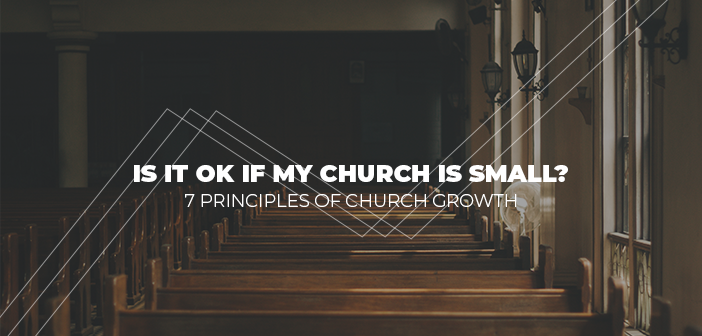Prefer to listen? Check out our conversation through this post on Episode 1 of The 95 Podcast.
As you well know, church growth is a BIG topic, and it’s one that creates a lot of disagreement. The topic of church growth has been used in many unhealthy ways over the years, causing a lot of pastors to experience insecurity about their ministry, and in some cases permitting some to become complacent.
Permission to Let Down Your Guard
Here at 95Network, our sole purpose is to resource small and mid-size churches (the 95% of churches under 500 in average attendance).
Translation: We LOVE small churches. We believe they are the backbone of the Church in America.
We know the topic of church growth is a tough one. And we know that many faithful ministry leaders have been hurt by how this topic has been addressed. So please know that we address this topic out of a love for small churches and a passion to invest in pastors.
If you have been hurt by this topic in the past, I just want to encourage you to take a quick moment to intentionally let down your guard as we think through the topic of church growth. We’re here to support you.
Here are 7 important church growth principles:
1) “Church Growth” and “Megachurch” are not synonymous.
Let’s start by defining our terms. As we’re supporting churches all across the country, we tend to hear a consistent knee-jerk reaction against the topic of church growth, and it usually sounds something like this: “I’m tired of hearing about growth. Not every church is supposed to be a megachurch.”
If that’s you, we get the frustration. But let’s clarify: that’s not what we’re talking about.
We’re not talking about the 100 barrier. We’re not talking about the 200 barrier. We’re not talking about the 500 barrier.
If your church averages around 40 in attendance on Sunday morning and you grow to 70 in average attendance, that’s church growth.
If your congregation grows in their relationship with Christ and begins to develop mission-minded relationships throughout the community, that’s church growth.
If your church averages around 100 in attendance on Sunday morning and you grow to 120 in average attendance, that’s church growth.
If your digital presence expands to influence more people in your community for Jesus, that’s church growth.
Church growth is simply the expansion of your church’s influence on your community, which flows out of your mission and vision. It’s good to set growth goals. It’s good to tweak things as you go. And it’s good to strive to see your community impact increase. (And that doesn’t mean that the goal is to become a megachurch.)
2) Every church should strive to experience growth BOTH deep and wide.
This is the phrase our team likes to use when we talk about growth. We desire churches to grow both deep and wide. We want them to grow deeper in their commitment to the Gospel and relationship with Jesus Christ. At the same time, we want them to grow wider as their level of influence on their community increases.
Both of those are important. And they both require intention.
The battle every church faces is the balance between an internal focus (growing “deep”) and an external focus (growing “wide”). This is a struggle you must address and wrestle with. Over-focusing on internal growth creates a church that is more interested in satisfying saints than saving sinners. And over-focusing on external growth creates a church with a loose foundation and an insecure team of leaders.
So is the goal church growth? Absolutely! Both inward and outward growth.
3) Small is relative.
95% of churches in the United States are under 500 in average attendance. And 87% of churches are under 200 in average attendance. So the vast majority of churches are what we would call small or mid-size.
But let’s be honest: A lot of those churches are actually rather large in relation to the size of their overall community.
This is where I’d like to make a quick note that there is NOT a certain size that your church “should” be. Be honest. Set goals. But don’t get stuck in the trap of feeling like you’re never doing enough. Or even more dangerous, that Jesus isn’t pleased with you because of the size of your church.
Pastor, your worth is not determined by how many people come to your church on Sunday. Don’t become complacent; it’s important to be honest about where you’re at. But we’ve all got to learn to sit back and enjoy the journey. As we like to say, ministry is WHAT you do; it is not WHO you are.
4) Building a biblical structure for growth is not optional.
This point is so important. There’s a common perspective among church leaders that “if God wants our church to grow, He’ll make it grow.” The truth in this statement is that God is always Who brings the increase (1 Cor. 3:7). However, this statement inevitably leads to complacency (which we discuss in the next point).
In Ephesians 4, we have a clearly laid out plan for how God wants our churches to be structured: “And he gave the apostles, the prophets, the evangelists, the shepherds and teachers, to equip the saints for the work of ministry, for building up the body of Christ…” (vv. 11-12)
When we make equipping saints an aspect of our leadership, we are promised 4 results:
An atmosphere of maturity.
“until we all attain to the unity of the faith and of the knowledge of the Son of God, to mature manhood, to the measure of the stature of the fullness of Christ…” (v. 13)
An atmosphere of stability.
“so that we may no longer be children, tossed to and fro by the waves and carried about by every wind of doctrine, by human cunning, by craftiness in deceitful schemes…” (v. 14)
An atmosphere of integrity.
“Rather, speaking the truth in love, we are to grow up in every way into him who is the head, into Christ…” (v. 15)
An atmosphere of community.
“from whom the whole body, joined and held together by every joint with which it is equipped, when each part is working properly, makes the body grow so that it builds itself up in love…” (v. 16)
There are some voices in church leadership circles that advocate that equipping leaders is not possible in small churches. Nothing could be further from the truth. If we want the increase, we have to model our churches in the way our God asked. Building a strong foundation and a healthy structure is the call of every church, no matter the size.
5) Being small isn’t a problem. Complacency is.
As I mentioned above, there’s not a specific size that your church “should” be. We should always strive for inward and outward growth. So the exact number of attendance/engagement is not the problem. But here’s what is:
Along with the perspective that “if God wants our church to grow, He’ll make it grow” is this statement: “We just need to preach the gospel.” Perhaps you’ve said those words yourself. Hidden behind that statement is the assumption that how and to whom you share the message of Christ with is irrelevant.
I’m sure you’ve heard the wise advice that if you keep doing what you’ve always done, you’ll keep getting what you’ve always got. But there are many church leaders who lead their ministry without critically thinking through how they do ministry, especially in a world that has changed drastically within the last 10-15 years.
Complacency could be defined as “uncritical satisfaction with oneself or one’s achievements.” Be careful that you don’t get to a point in ministry where you stop casting vision or stop setting goals because you feel like there is nothing else worth striving for.
6) Healthy leadership is crucial to a healthy church.
A church will never grow beyond its leadership. The lid of your leadership is the lid of your church’s healthy growth. Whether you’re struggling with insecurity or in need of training as a leader, your church is in need of leadership with clear vision, healthy perspective, and humble confidence. Here are the 3 risk factors of unhealthy leadership:
Insecurity. John Maxwell has said, “Leaders who are insecure or egocentric, they basically sabotage themselves.” Insecure leaders will feel intimidated by empowering people who are better than them at something. They will make decisions that please people instead of pushing the ministry forward. And they will consciously or subconsciously keep the organization at a place where they feel comfortable.
Attitude. A bad attitude will spread like a disease if left unchecked, killing momentum and draining the energy from the entire organization. Whether this surfaces itself as resentment towards another person in your church or frustration about the situation your church is in, a bad attitude is a killer of healthy growth.
Perspective. Healthy perspective is the currency of clear vision and effective ministry. Without it, leaders struggle to be honest about the current health of their church, they quickly begin to become inwardly focused and outwardly ineffective, and they may even begin to dislike the community outside the four walls of their church. When a leader regains perspective, they are able to set goals for the future and maintain their passion for the actual mission of the Church.
7) Today, church growth can mean more than attendance increase.
You’ve probably heard that we are living through the greatest communications shift in 500 years. And you may have heard quite a few church leaders discuss how engagement is going to be more important to track than attendance moving forward.
But here’s the reality: Digital communication has completely shifted the way people communicate and interact with organizations they care about. A study recently showed that 97% of people interact with local organizations online. (I think we can all agree that 97% is basically everyone.) Pastor, your digital presence is no longer an “add-on” to your ministry; it is your ministry.
A friend of mine once told me, “Culture is like gravity. You can spend your whole life fighting against it, you can ignore its implications, or you can learn how to leverage it.” And those are the 3 options we have as we approach this shift in communications. We can fight it, we can ignore it, or we can leverage it.
The consistent gathering of the saints is absolutely important. But the growth of your ministry doesn’t have to be restricted to how many people show up to that gathering. Begin asking a few questions:
- How can our church use our digital presence as ministry instead of as promotion?
- How can we engage people in our community before they ever attend our church?
- How can we engage our congregation outside Sunday morning?
- Are we currently utilizing digital tools (website, social media, email, etc.) in an active way or a passive way?
Church growth can be a tough topic. But it’s one that shouldn’t be ignored. Is there anything you would add to this list?
Want to get a jumpstart on building a healthy structure? Investing in the health of your church doesn’t require a big budget. Learn how VisionBox can help you and your team gain clarity for the future:








